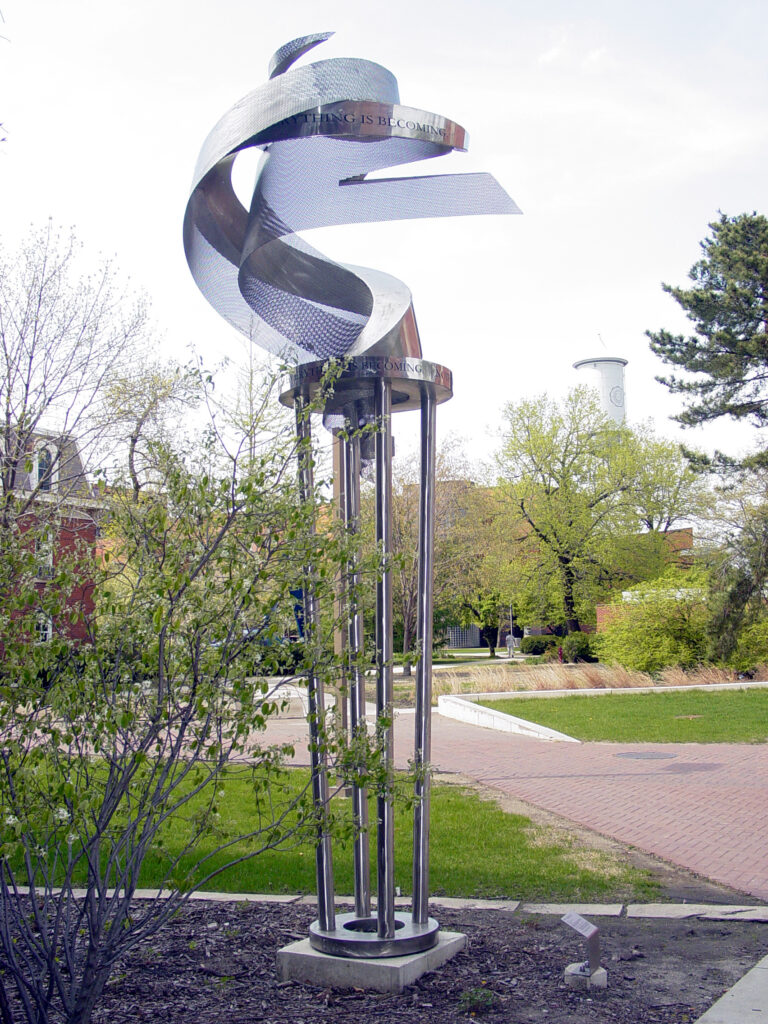
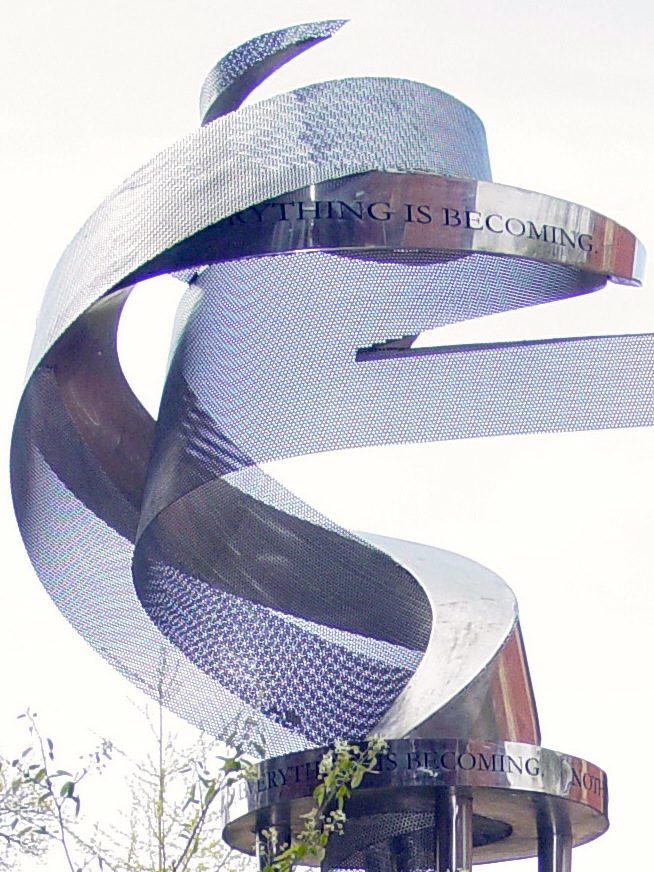
About the Art
Tucked away among the trees near the Student Services Building is a visual reminder of Iowa State University. Purchased by the Iowa Art in State Buildings Program in 2002, Air Spiral, with its sturdy base and twisting forms, suggests a fervent upward spiral to success. The spiral form is a cross-cultural motif, bearing an undeniable resemblance to the symbol of the Iowa State University Cyclone mascot. Students in transition often want an answer, which many of life’s questions simply do not have. The quote emblazoned across the spiral, is from the Greek philosopher Heraclitus, “Nothing ever is, everything is becoming.” Though life is uncertain, it reminds us that the world keeps spinning.
The designer, Susan Fiene, described the spiral form as representing a dichotomy of positive and negative existence within the same symbol. The quote by Heraclitus sets up an impossibility and then counters it with a positive assertion. It offers direction and reassurance about the process of personal and intellectual growth.
About the Artists
Susan Fiene (Brown) is a Minnesotan artist and a member of the feminist art collective WARM, the Women’s Art Registry of Minnesota. Born in 1946, Fiene’s art is the result of careful mathematical calculations and connections to nature.
Fiene’s art can be viewed below.
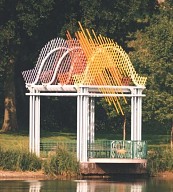
Tea House on Powderhorn Lake, Minneapolis, Minnesota
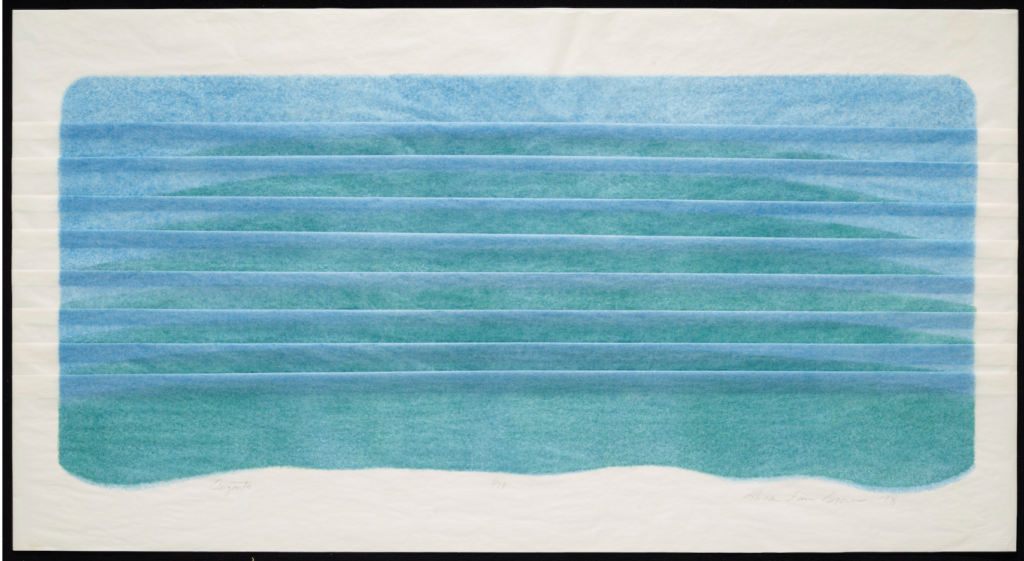
Orizonte from Portfolio 15 (#10), 1978, Walker Art Center, Minneapolis, Minnesota
Tom Stancliffe, one of two of the fabricating artists, is a Chicago-born sculptor (b. 1955) who operates a large studio outside of Cedar Falls, Iowa. He is best known for his large public sculptures of bronze or stainless steel expressed in both historical and contemporary contexts of the installation site. Stancliffe has completed over 30,000 single or joint public art installations, including Carom included in this book.
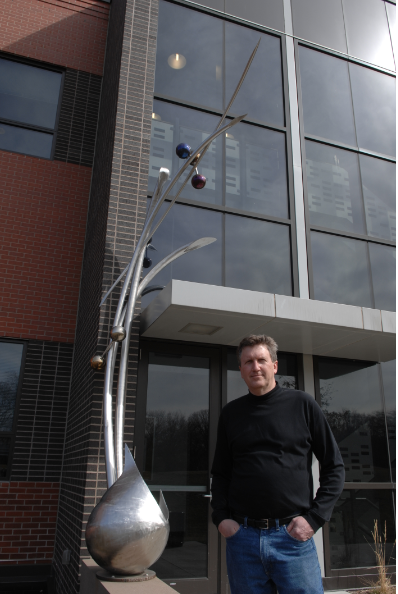
Tom Stancliffe with Glean #1 at Iowa State University, 2003, created for the entrance to Carver Co-Lab
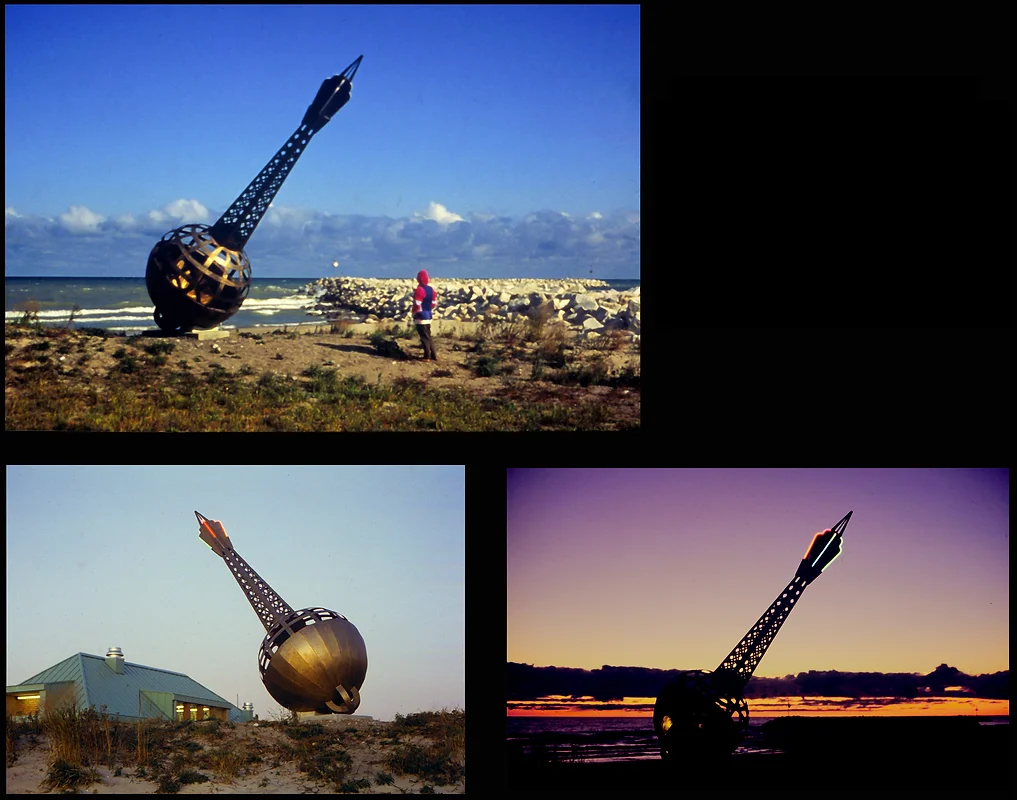
Argo, 1991, North Point Marina, Winthrop Harbor, Illinois
Glenn Williams is the second fabricating artist of Air Spiral. Williams (b. 1972) is an associate professor of sculpture at the University of Wisconsin, Milwaukee. His work explores various constructs in politics, society or the environment. He reconstructs and reflects various norms to expose and question their impact on varying social realities. Williams is interested in how these constructs shape our understanding of the world around us and influence our human interactions.
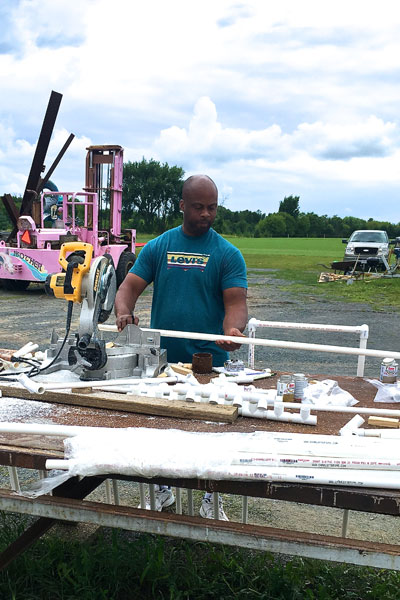
Glenn Williams working on a sculpture made from PVC pipe
Relevant Terminology/History
Art Fabrication is the process or service of producing large or technically difficult artworks through entities and resources beyond an individual artist. Art fabrication companies have access to the resources, specialized machinery, technologies, and labor necessary to execute complex projects.
Philosopher is a person who offers views or theories on profound questions in ethics, metaphysics, logic, and other related fields
Heraclitus (c.540 BCE – c.480 BCE) was a Greek philosopher remembered for his belief that fire formed the basic material of an orderly universe. His understanding of the relation of opposites to each other (i.e., health and disease, hot and cold, good, and evil) helped him overcome the chaos and divergent nature of the world. Little is known about his life and the one book he is believed to have written remains lost.
His ideas have survived in short quotes attributed to him by later authors, including Plato. Below are some additional Heraclitus quotes:
- No man ever steps in the same river twice, for it’s not the same river and he’s not the same man.
- There is nothing permanent except change.
- Good character is not formed in a week or a month. It is created little by little, day by day. Protracted and patient effort is needed to develop good character.
- If you do not expect the unexpected you will not find it, for it is not to be reached by search or trail.
- Man is most nearly himself when he achieves the seriousness of a child at play.
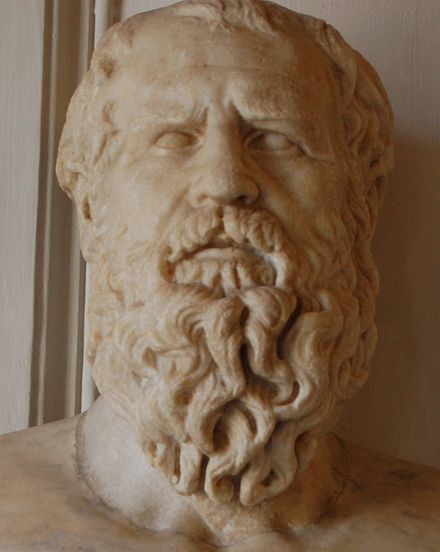
A bust of Heraclitus, from the Hall of philosophers in the Capitoline Museums in Rome.
Plato (428 BCE – 348 BCE) may have been primarily influenced by Socrates, since he is often the main character in many of his writings, but scholars generally believe he was influenced by Heraclitus, Parmenides, and the Pythagoreans. Plato interpreted Heraclitus to have believed that the material world is in constant change.

Bust of Plato, courtesy of Wikipedia
Cyclone is a system of winds rotating inward to an area of low atmospheric pressure, with a counterclockwise (northern hemisphere) or clockwise (southern hemisphere) circulation.

Image courtesy of Wikipedia
Cy the Cardinal is the Iowa State University mascot. The name is believed to have originated in 1895, when Iowa suffered an unusually high number of cyclones.

Image courtesy of Wikipedia
Learning Guide

- What do you think the title has to do with the art?
- Why do you think Number Character 6 is speaking about the art?
- How does the red image with white numbers relate to the art? Can you find it in the art?
- How does the hidden blue image relate to the art?
- How does Air Spiral look like a cyclone?
- Where do you think Cy the Cardinal would want to sit on Air Spiral? Why?
- With Air Spiral standing 17 feet tall, how many of you would it take to be taller than Air Spiral?
- Why do you think Air Spiral required two fabricating artists?
- Which of Heraclitus’ quotes listed above (or the one engraved in Air Spiral) do you like the best? Why?
- Why do you believe the Heraclitus quotes were listed above using Roman numerals?
- How does Heraclitus quote IV above relate to web searches today? How about the future of Artificial Intelligence?
- Which of the Heraclitus quotes above (or the one engraved in Air Spiral) do you think relate to The Numbers Lady believing appropriate math lessons require exploring how the math relates to daily life?
- Why do you think cyclones in the southern hemisphere move in the opposite direction as in the northern hemisphere? Do you think it might be same as water going down a drain in the northern or southern hemispheres? What do you think the direction of the water going down a drain would be if the drain were situated directly on the Equator? Do you think a cyclone could exist only on the Equator? Why or why not?
